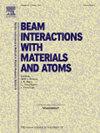化学短程有序对中熵铬钴镍合金位移级联的影响
IF 1.4
3区 物理与天体物理
Q3 INSTRUMENTS & INSTRUMENTATION
Nuclear Instruments & Methods in Physics Research Section B-beam Interactions With Materials and Atoms
Pub Date : 2024-11-21
DOI:10.1016/j.nimb.2024.165581
引用次数: 0
摘要
化学短程有序(CSRO)是高/中熵合金(H/MEAs)中的一种重要结构,它对辐照材料的机械性能有重大影响。本研究通过分子动力学(MD)模拟研究了 CSRO 对中熵铬钴镍合金位移级联过程中点缺陷演化的影响。为了验证 CSRO 对点缺陷的影响,首先对合金进行了多位移级联。结果表明,CSRO 结构可显著降低位错和缺陷密度。然后,讨论了单位移级联下 CSRO 结构对点缺陷的影响。在单位移级联过程中,点缺陷的峰值数量和存活点缺陷的数量都随着CSRO程度的增加而减少,这表明CSRO增强了辐照材料的抗辐照能力。CSRO 中的富镍区因其较高的形成能垒而能抑制点缺陷的形成。而 CSRO 中的 Co-Cr 区域由于迁移能较低,可促进点缺陷的迁移,从而促进点缺陷的重组。目前的工作为理解辐照诱导的缺陷演变和辐照 M/HEAs 的机械性能提供了新的见解。本文章由计算机程序翻译,如有差异,请以英文原文为准。
Effects of chemical short-range order on displacement cascade in medium-entropy CrCoNi alloys
Chemical short-range order (CSRO) is an important structure in high/medium entropy alloys (H/MEAs), which has a significant influence on the mechanical properties of irradiated materials. In this work, molecular dynamics (MD) simulations are performed to investigate the effects of CSRO on the point defect evolution during displacement cascade in medium-entropy CrCoNi alloys. To validate the influence of CSRO on point defects, multi-displacement cascades were initially conducted on the alloy. The results indicate that the CSRO structure can notably diminish dislocation and defect densities. Then, the influence of the CSRO structure on point defects under single displacement cascade was discussed. Both the peak number of point defects and the number of surviving point defects decrease with the increasing degree of CSRO during the single displacement cascade, indicating that the CSRO enhances the irradiation-resistance of irradiated materials. The Ni-rich region in CSRO can inhibit the formation of point defects due to its higher formation energy barrier. While the Co-Cr region in CSRO was found to promote the migration of point defects that can facilitate their recombination due to the lower migration energy. The current work provides new insights into understanding the evolution of irradiation-induced defects and mechanical properties of irradiated M/HEAs.
求助全文
通过发布文献求助,成功后即可免费获取论文全文。
去求助
来源期刊
CiteScore
2.80
自引率
7.70%
发文量
231
审稿时长
1.9 months
期刊介绍:
Section B of Nuclear Instruments and Methods in Physics Research covers all aspects of the interaction of energetic beams with atoms, molecules and aggregate forms of matter. This includes ion beam analysis and ion beam modification of materials as well as basic data of importance for these studies. Topics of general interest include: atomic collisions in solids, particle channelling, all aspects of collision cascades, the modification of materials by energetic beams, ion implantation, irradiation - induced changes in materials, the physics and chemistry of beam interactions and the analysis of materials by all forms of energetic radiation. Modification by ion, laser and electron beams for the study of electronic materials, metals, ceramics, insulators, polymers and other important and new materials systems are included. Related studies, such as the application of ion beam analysis to biological, archaeological and geological samples as well as applications to solve problems in planetary science are also welcome. Energetic beams of interest include atomic and molecular ions, neutrons, positrons and muons, plasmas directed at surfaces, electron and photon beams, including laser treated surfaces and studies of solids by photon radiation from rotating anodes, synchrotrons, etc. In addition, the interaction between various forms of radiation and radiation-induced deposition processes are relevant.

 求助内容:
求助内容: 应助结果提醒方式:
应助结果提醒方式:


